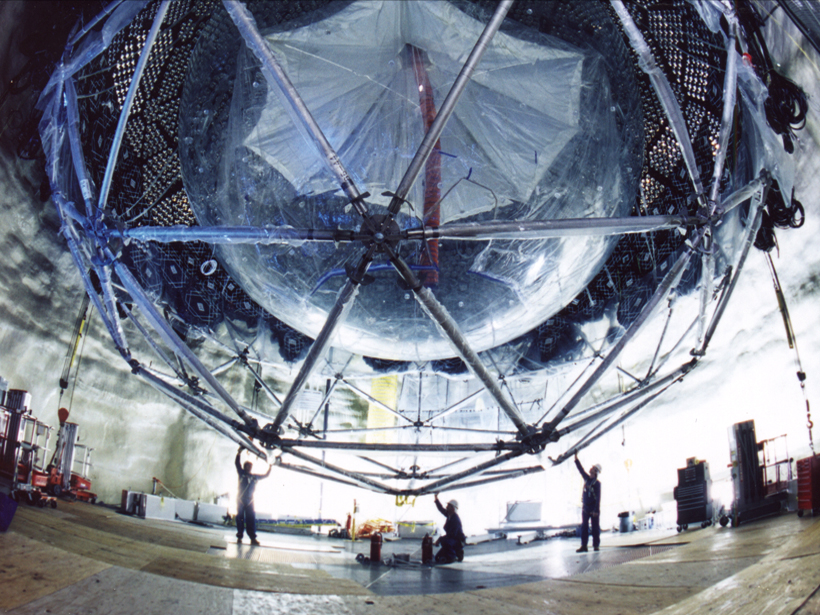Physicists Takaaki Kajita from the University of Tokyo in Japan and Arthur B. McDonald of Queen’s University in Kingston, Ontario, Canada, received the Nobel Prize in Physics yesterday for their pioneering discovery that neutrinos, elusive subatomic particles that are constantly streaming through all of space, even straight through the Earth, can change from one form to another. This finding in turn proved that the tiny particles have mass—a discovery that challenges the prevailing theory of particle physics, known as the standard model.
In the process of discovering the neutrino’s changeable nature, the scientists also solved a decades-long mystery about the Sun: the case of the “missing” neutrinos.
There are three kinds of neutrinos penetrating the Earth from every direction: electron, tau, and muon. Some of these neutrinos have been around since the big bang; some were released by supernovas. Neutrinos also come from the Sun and from radioactive decay on Earth, cosmic rays hitting the Earth’s atmosphere, and even radioactive materials within our own bodies, among other sources.
They found only a third of the neutrinos they expected.
In the 1960s, scientists were investigating the theory that the Sun’s energy comes from nuclear fusion of hydrogen into helium deep within its core—a reaction that releases neutrinos, which zip through the Sun toward Earth. Because the reaction happens so frequently, scientists expected to find a vast number of neutrinos hitting the Earth. However, their models disagreed with experimental evidence—they found only a third of the neutrinos they expected. So where were the missing neutrinos?
Mystery Solved
It turns out that the neutrinos were there, but some had morphed. In the experiments that helped secure their Nobel Prize, both McDonald and Kajita helped make this discovery.
In 1998, Kajita and his team at the Super-Kamiokande Neutrino Detector deep below Gifu, Japan, noticed that the number of muon neutrinos coming from the atmosphere above was different than the number traveling through the Earth. Because the Earth does not present any obstacle to neutrinos, these numbers should be the same. They concluded that the muon neutrinos that had traveled farther—through the Earth—underwent an “identity” change and transformed into tau neutrinos, which weren’t detectable by their instruments.
Meanwhile, McDonald and his team at the Sudbury Neutrino Observatory 2 kilometers underground in Ontario were also investigating the “missing neutrino” problem. Their experiments featured two ways of counting neutrinos—one for counting only electron neutrinos and one for counting all three types as a lump sum. When counting only electron neutrinos, the scientists found only a third of the expected number. But when counting the lump sum of neutrinos, the expected number was there. That meant that the neutrinos emitted by the Sun can change into muon and tau neutrinos during their 150-million-kilometer journey toward Earth.
“This shows that we understand how the Sun shines.”
“The solution of the mystery of the missing neutrinos is an important triumph for astronomy,” John Bahcall, a Princeton University astrophysicist who pioneered the original solar neutrino research in the 1960s, wrote in 2004 about McDonald’s and Kajita’s work for NobelPrize.org, the prize’s official website. “This shows that we understand how the Sun shines, the original question that initiated the field of solar neutrino research.” Bahcall died in 2005.
The Bigger Picture
“Trying to answer a question that we find right here in our own neighborhood” led to the discovery of neutrino mass, noted Georgia de Nolfo, an astrophysicist at NASA’s Goddard Space Flight Center in Greenbelt, Md., who was not involved in the prize-winning research.
“We’re trying to understand the Sun, and in doing that discovered something much bigger,” de Nolfo continued. The fact that neutrinos can switch types and have mass “affects the evolution of the universe and the structure of matter as we understand it.”
—JoAnna Wendel, Staff Writer
Citation: Wendel, J. (2015), Physics Nobel winners also solved solar mystery, Eos, 96, doi:10.1029/2015EO036985. Published on 7 October 2015.
Text © 2015. The authors. CC BY-NC 3.0
Except where otherwise noted, images are subject to copyright. Any reuse without express permission from the copyright owner is prohibited.

